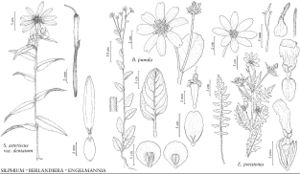Engelmannia
Trans. Amer. Philos. Soc., n. s. 7: 343. 1840.
| Taxon | Illustrator ⠉ | |
|---|---|---|
 | Silphium asteriscus Berlandiera pumila Engelmannia peristenia | Yevonn Wilson-Ramsey John Myers John Myers |
Perennials, 20–50 (–100) cm (taproots or caudices becoming woody). Stems erect (coarsely strigose, hispid, or hirsute), usually branched (at least distally, sometimes branched from bases, aerial stems multiple). Leaves basal and cauline; alternate; petiolate (basal and proximal cauline) or sessile (distal); blades (pinnately nerved) mostly oblong to lanceolate, usually 1 (–2) -pinnately lobed, bases ± cuneate, ultimate margins entire, faces coarsely strigose, hispid, or hirsute. Heads radiate, in open, corymbiform arrays. Involucres hemispheric, 6–10 mm diam. Phyllaries persistent (outer) or falling (inner, with cypselae), mostly 18–24+ in ± 3 series (outer with relatively short, expanded, indurate bases and longer, linear, herbaceous tips, inner broadly ovate, mostly indurate, scarious-margined, herbaceous tips relatively broader and shorter, tending to split along midveins in age). Receptacles flat, paleate (paleae linear to narrowly oblong, hirsute-ciliate at tips). Ray-florets 8–9 (each subtended by an inner phyllary), pistillate, fertile; corollas yellow (laminae oblongelliptic, entire or minutely 2–3-toothed). Disc-florets 25–50, functionally staminate; corollas yellow, tubes shorter than campanulate throats, lobes 5, ± deltate (anthers black, appendages deltate, obtuse; styles not branched). Cypselae obcompressed or obflattened, obovate (each falling with subtending phyllary, 2–4, indurate paleae, plus sterile ovaries of 2–4 disc-florets, margins ± ciliate, faces strigose to pilose); pappi persistent or tardily falling, of 2–4, ciliate scales. x = 9.
Distribution
sw United States, n Mexico
Discussion
Species 1.
Selected References
None.
Lower Taxa
"broader" is not a number.